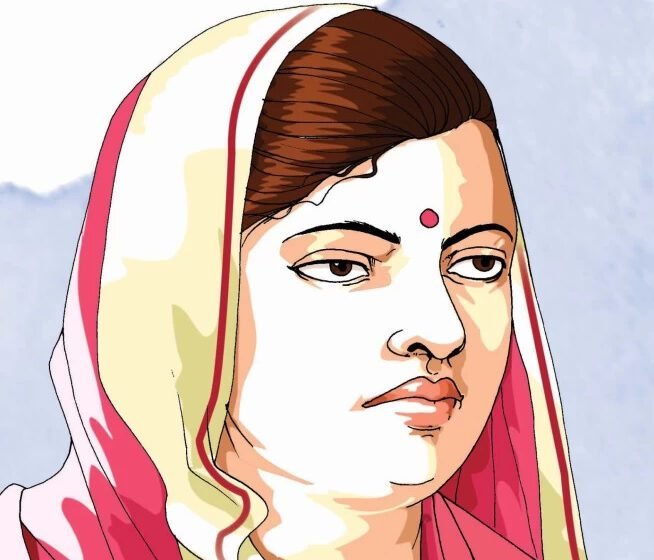Subhadra Kumari Chauhan: A Rebellious Patriot and Ineffable Poetess

Everyone must have heard of Subhadra Kumari Chauhan, the poet of the magnificent poem ‘Jhansi Ki Rani’. We all know she was an astounding poetess but a very few people know she was also a fierce freedom fighter. Subhadra Kumari Chauhan was a staunch feminist, poetess, and freedom fighter. She is undoubtedly the epitome of women empowerment. She broke all the shackles of patriarchy, caste, racism, and religion through her eloquent poems.

She was so valiant that she went against the society at a time when patriarchy and casteism was at peak and got education. She truly is a source of inspiration for millions of women today. In this blog we will examine the extraordinary life of one of the greatest Indian poets Subhadra Kumari Chauhan.
History
Subhadra Kumari Chauhan was born in 1904 in Nihalpur Village near Allahabad into a Rajput family. Her parents were very pious and orthodox. She grew up in this orthodox and conservative milieu where untouchability, caste, and patriarchy were a big deal. Her father was Thakur Ram Nath Singh who was very stringent about social norms and customs and vehemently adhered to them. The silver lining in Subhadra Kumari’s life however was her elder brother Raj Bahadur Singh who was a liberal and challenged these societal norms and customs. He helped Subhadra Kumari Chauhan to get education by getting her admission in Crossthwaite Girls’ School in Allahabad. Subhadra Kumari Chauhan was a senior of her contemporary Mahadevi Verma here. Subhadra Kumari Chauhan and Mahadevi Verma had become very close friends here and they often spent time together writing poems and reviewing each other’s works. It won’t be wrong to say both motivated each other to refurbish their poetry skills.

At a tender age of 15, Shubhadra Kumari Chauhan was tied the knot with Lakshman Singh Chauhan of Khandwa. However, she didn’t relinquish her studies after marriage and kept studying diligently. Soon after her marriage she achieved a scholarship at the middle school level. Her husband Lakshman Singh Chauhan was a freedom fighter so he went to Jabalpur to join Mahatma Gandhi’s non-cooperation movement. At that time Subhadra Kumari Chauhan was studying at Theosophical School in Varanasi. But getting inspired from her husband she gave up studies and set to join her freedom fighter husband in Jabalpur and contribute to the national freedom struggle.
There was no looking back once she joined the national freedom struggle. She fought intrepidly and with full valor. She became the first woman satyagrahi in 1923 when she launched a procession with the Congress tricolor flag defying the government orders. The procession was launched in response to earlier cruelty by the police who had pulled down and trampled the flag. This was the time when national freedom struggle was at its zenith and all the Indians were sick and tired of the British colonial government. Anger and revolution were in air. This was when Subhadra Kumari Chauhan and her husband decided to lead a group of satyagrahis from Jabalpur.

In 1930s Shubhadra Kumari Chauhan led the women wing of the State Congress Committee. She was arrested in 1940s while protesting in civil disobedience movement. She was arrested twice between 1924-42. However, it didn’t shatter her courage and tenacity. In fact, she came out stronger. She left her little children behind and happily languished behind bars but when she came out, she continued her revolt with equal intensity.
In 1936 and 1946 she was elected to the Bihar legislative assembly unopposed. Even during this turmoil Shubhadra Kumari Chauhan never gave up on her poems and stories. She made poetry a weapon of expressing her feelings and national freedom struggle.

Her first poem was published in 1913 when she was only nine years old. The language of her poems was khariboli which is very explicit and easily fathomable. She was an active member of many literary societies and attended plethora of kavi sammelan. Her evocative poems paint a vivid picture of patriarchy, casteism, and rising nationalism in the society. Her heartfelt poem ‘Jhansi Ki Rani’ is sung till date.
Literature
Subhadra Kumari Chauhan has embellished the Hindi literature with her myriads of poems. Some of her famous poems are:
- Jhansi Ki Rani – It celebrates Rani Lakshmibai’s bravery during the 1857 rebellion against British rule. The poem highlights her strength, determination, and patriotism as she fights for her kingdom and people, serving as a powerful tribute to her legacy and spirit of resistance.
- Jallianwala Bagh mein Vasant – It reflects on the tragic events of the Jallianwala Bagh massacre in 1919. The poem contrasts the beauty of spring with the sorrow and bloodshed experienced by the people, highlighting the loss of innocence and the enduring spirit of resilience amid tragedy.
- Veeron Ka Kaisa Ho Basant – It celebrates the spirit of bravery and sacrifice of warriors and freedom fighters. The poem emphasizes that spring, a time of renewal, should honor those who fought for freedom. It calls for a remembrance of their courage and the need to uphold their legacy with pride and respect.
- Rakhi Ki Chunauti – highlights the themes of brotherhood and bravery. The poem presents Raksha Bandhan as a call for the brother to protect not only his sister but also justice and freedom, emphasizing the importance of standing against oppression and fulfilling one’s duty.
- Vida – It expresses the deep emotions of farewell and separation. The poem captures the bittersweet feelings of parting from loved ones and cherished memories. It highlights the pain of goodbye while celebrating the enduring bonds that remain, showcasing the resilience of the human spirit.
- Yeh Kadamb Ka Ped – It describes the beauty and significance of the kadamb tree. The poem evokes feelings of nostalgia, love, and connection to nature. It symbolizes strength and resilience, reflecting the deep emotional ties people have with their surroundings and the memories associated with them.

Novels
The novels of Subhadra Kumari Chauhan are:
- Mukul – It’s a popular collection of her poems.
- Bikhre Moti – It’s a collection of her short stories.
Achievements
The notable achievements of Subhadra Kumari Chauhan are:
- The government of Madhya Pradesh has put a statue of Subhadra Kumari Chauhan in front of the municipal corporation office of Jabalpur.
- India posts released a postage stamp of her on 6 August 1976 to pay homage to the great poetess.
- Google commemorated Subhadra Kumari Chauhan on her 117th birthday with a doodle on 16 August 2021.
- The ICGS Subhadra Kumari Chauhan, an Indian Coast Guard ship was named after her.
- Many of her poems are a part of CBSE school curriculum.
- She was awarded Seksaria prize in 1930 by All India Hindi Sahitya Sammelan for her book ‘Mukul’ and ‘Bikhre Moti’.

Legacy
Subhadra Kumari Chauhan breathed her last breath on 15 February 1948. She left this world at a very young age of 44. Her writings have undoubtedly left an indelible mark on the world and that is why she is still remembered, read, and published. Her poems addressing the sensitive and pervasive issues of caste, nationalism, and women empowerment are pertinent hitherto.
Subhadra Kumari Chauhan was the embodiment of a fierce nationalist, staunch feminist, and ardent caste emancipator. She is an inspiration for millions of Indians. We should read her works at least once in our life!


